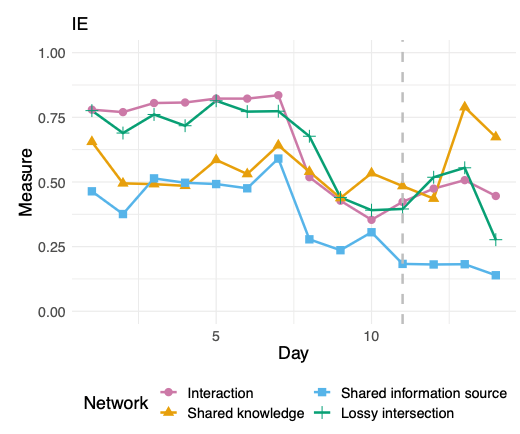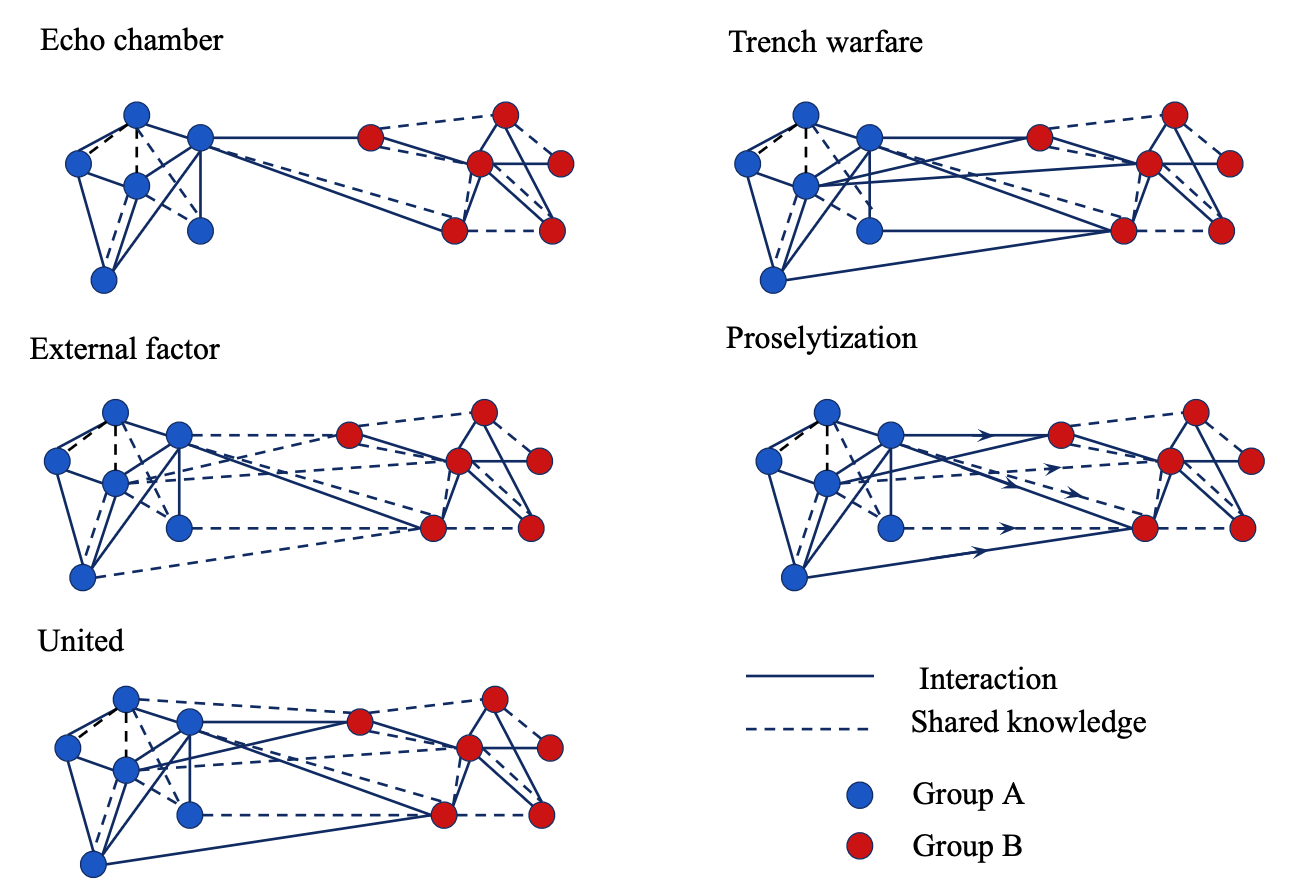
A high-dimensional network and organizational form approach to measure and interpret polarization on social media
By Samantha Phillips
Tags: Polarization; social media; social network analysis
Publications:
Phillips, S. C., & Carley, K. M. (2023). An organizational form framework to measure and interpret online polarization. Information, Communication & Society, 1-33. https://doi.org/10.1080/1369118X.2023.2240580.
Phillips, S. C., Uyheng, J., & Carley, K. M. (2023). A high-dimensional approach to measuring online polarization. Journal of Computational Social Science, 1-32. https://doi.org/10.1007/s42001-023-00227-6.
There has been growing concern regarding the consequences of political and social polarization in recent years due to seeming increases in partisan animosity and division. Despite general consensus that social media facilitates polarization, there is conflicting evidence about the extent to which and mechanisms in which social media does so. In these works, we aim to assist analyses of discussion and group dynamics on social media such that polarization, the ideological and psychological distancing between groups, can be approximated solely with user-generated content.
High-dimensional network approach to measure polarization
Typically, measures of online polarization only consider direct communication between users. This does not capture differences and similarities in narratives between and within groups, motivating a high-dimensional network methodology that detects the presence of the following conditions in online discourse:
- Group membership: definition of group membership of two mutually exclusive groups holding opposing ideologies towards a topic or set of topics
- Awareness: ideologically opposed groups are aware of the collective narratives of the outgroup
- Social dimension: high levels of direct communication within groups and low levels between groups
- Knowledge dimension: high levels of shared ideas, arguments, and phrases (referred to as knowledge bits) within groups and low levels between groups
- Source dimension: high levels of shared opinion leaders, media, and organizations (referred to as knowledge sources) within groups and low levels between groups
We applied the proposed methodology to discussions surrounding the COVID-19 vaccine on Twitter in December 2020. The figure below displays the value of the average I/E index (see the paper for measure details and selection process) applied to the interaction, shared knowledge, shared knowledge source, and lossy intersection networks between December 1, 2020 and December 14, 2020. In this example, the shared knowledge network is a user x user network where there’s an edge if two users use the same hashtag in a post. There is an edge between users in the shared knowledge source network if they both use the same URL or @-mention the same user in a post.

Average I/E index of pro- and anti-vaccine discussion between December 1, 2020 and December 14, 2020. The vertical dashed gray line denotes December 11, 2020. Credit: figure created by Joshua Uyheng
As more pro- and anti-vaccine users discuss the official announcement of the first emergency authorization of a COVID-19 vaccine on December 11, 2020, there is a collapse in the range of sources (URLs, @-mentions) referenced across groups. Yet we see each group continues to use different knowledge (hashtags) in their posts, as their position towards the common sources are opposed. The divergence in the level of polarization across dimensions emphasizes the importance of considering multiple ways division occurs through a high-dimensional approach. Each dimension can be affected by events differently, which has implications for understanding drivers of online discussion dynamics.
Organizational forms to interpret polarization
We use organizational forms to extend the proposed high-dimensional approach to characterize online polarization between groups beyond `high' and `low' levels of polarization. An organizational form is defined as “a common set of characteristics, readily identifiable by outside populations and clearly bounded”. These structural forms encapsulate distinctive attributes of the given community or set of communities.
The organization form framework contains five major community-level organizational forms of online polarization: echo chamber, trench warfare, external factor, proselytization, and united. In addition, nine subforms based on intragroup dynamics of each polarized community are specified, such as symmetrical, asymmetrical group, and interaction-focus.
 Schematic representation of differences in intergroup communication and shared knowledge in major forms of polarization. Credit: Samantha Phillips
Schematic representation of differences in intergroup communication and shared knowledge in major forms of polarization. Credit: Samantha Phillips
The methodology to identify the organizational form was applied to discourse about the 2022 U.S. Midterm elections in Pennsylvania on Twitter and Reddit. On Twitter, Democrat-designated and Republican-designated users represent echo chambers with symmetrical subform. Both communities distinctly communicate and share knowledge in a highly connected fashion within but not between them. On Reddit, Republican-designated users rarely comment or use the same subreddits or URLs as Democrat-designated users. However, Democrat-labeled users are not nearly as separated from opposing content or sources, commenting on posts by Republican-labeled users disproportionately. Taking the intragroup and intergroup dynamics together, we showed the PA midterm discussion on Reddit has an interactive proselytization form with the asymmetrical group subform.
Policy implications
The proposed framework for detecting and interpreting online polarization has implications for depolarization interventions and policies. For example, the role of echo chambers and intergroup contact in increasing polarization between communities online is highly contested. By comparing online polarized communities classified as echo chamber, proselytization, or trench warfare, we can investigate confounding factors (e.g., political elites and media) and emergent societal effects of each form. Identification of predictive interaction and knowledge structures of controversial online discussions that lead to adverse offline effects helps social media platforms and advocacy groups effectively mitigate such escalation.
